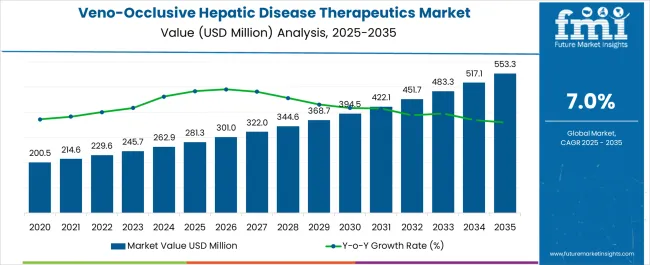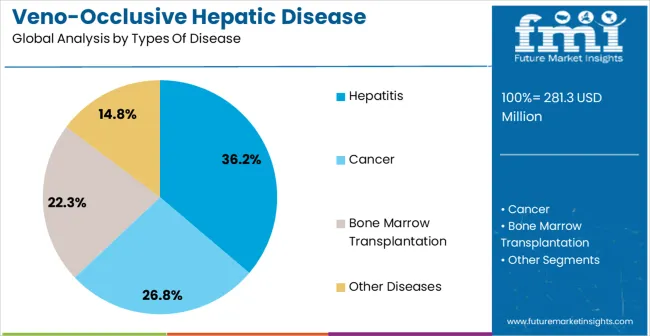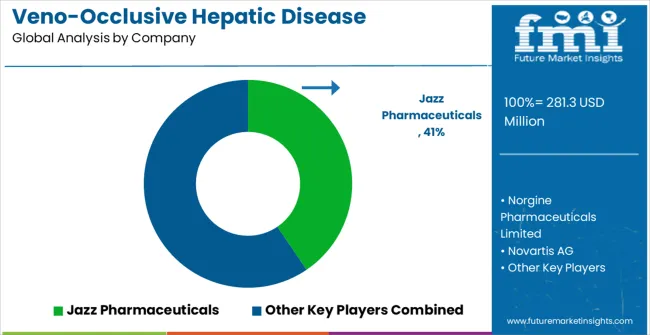The Veno-Occlusive Hepatic Disease Therapeutics Market is estimated to be valued at USD 281.3 million in 2025 and is projected to reach USD 553.3 million by 2035, registering a compound annual growth rate (CAGR) of 7.0% over the forecast period.

| Metric | Value |
|---|---|
| Veno-Occlusive Hepatic Disease Therapeutics Market Estimated Value in (2025 E) | USD 281.3 million |
| Veno-Occlusive Hepatic Disease Therapeutics Market Forecast Value in (2035 F) | USD 553.3 million |
| Forecast CAGR (2025 to 2035) | 7.0% |
The Veno-Occlusive Hepatic Disease Therapeutics market is experiencing notable expansion, driven by the increasing prevalence of liver-related complications and heightened awareness about rare hepatic disorders. Growing cases of hepatitis, liver transplant complications, and oncology-related liver conditions are creating a pressing need for effective therapeutic solutions. Advances in pharmacological treatments and supportive care strategies have accelerated the development of specialized drug classes, with increasing investments in research programs focusing on improving clinical outcomes.
Regulatory approvals for novel therapeutics, alongside expanding access to healthcare in emerging markets, are supporting demand growth. The rising emphasis on early diagnosis and the adoption of advanced imaging and biomarker-based monitoring tools are further strengthening treatment pathways. Healthcare providers are prioritizing therapies that address both disease progression and related complications, ensuring better patient survival rates.
The market is also shaped by growing collaborations between pharmaceutical companies, research institutes, and healthcare systems to develop innovative therapeutic protocols As the incidence of veno-occlusive hepatic conditions rises globally, driven by lifestyle changes, genetic predispositions, and higher exposure to chemotherapy, the market is expected to witness consistent long-term growth.
The veno-occlusive hepatic disease therapeutics market is segmented by types of drugs, types of disease, end-user, and geographic regions. By types of drugs, veno-occlusive hepatic disease therapeutics market is divided into Antimicrobials, Antivirals, Antithrombotic, Anti-Ischemic, Anti-Inflammatory, and Others. In terms of types of disease, veno-occlusive hepatic disease therapeutics market is classified into Hepatitis, Cancer, Bone Marrow Transplantation, and Other Diseases. Based on end-user, veno-occlusive hepatic disease therapeutics market is segmented into Hospitals, Research Institutes, and Ambulatory Surgical Centres. Regionally, the veno-occlusive hepatic disease therapeutics industry is classified into North America, Latin America, Western Europe, Eastern Europe, Balkan & Baltic Countries, Russia & Belarus, Central Asia, East Asia, South Asia & Pacific, and the Middle East & Africa.

The antimicrobials segment is projected to hold 39.4% of the Veno-Occlusive Hepatic Disease Therapeutics market revenue in 2025, making it the leading drug type. Growth in this segment is being driven by the critical role antimicrobials play in managing infections that frequently complicate hepatic disorders. Patients with liver dysfunction are particularly vulnerable to opportunistic infections, making antimicrobial therapy essential for reducing mortality and improving quality of care.
Advances in drug formulations and the integration of antimicrobial stewardship programs within healthcare facilities have enhanced the effectiveness and safety of these treatments. Widespread use in hospitals, coupled with continuous innovation in broad-spectrum and targeted antimicrobials, is further reinforcing adoption. The ability of antimicrobial therapies to prevent secondary infections and mitigate complications is strengthening their clinical relevance in the management of veno-occlusive hepatic disease.
Growing emphasis on combination therapies, in which antimicrobials are used alongside other treatment classes, is also expanding their role As the global burden of hepatic complications rises, supported by increasing patient awareness and diagnostic improvements, the antimicrobials segment is expected to maintain its dominant position in the market.

The hepatitis segment is anticipated to account for 36.2% of the Veno-Occlusive Hepatic Disease Therapeutics market revenue in 2025, underscoring its significant contribution to demand. Hepatitis-related conditions are among the most common causes of hepatic complications, making them central to therapeutic strategies. The rising prevalence of hepatitis B and C infections worldwide has created a pressing need for targeted therapies that address disease progression and prevent further liver damage.
Advances in antiviral treatments, alongside immunomodulatory drugs, have improved survival rates and reduced long-term complications for patients with hepatitis-linked hepatic conditions. Governments and global health organizations are implementing awareness campaigns and vaccination programs that are driving early diagnosis and treatment adoption. The growing availability of innovative therapeutic protocols is strengthening patient outcomes while expanding access across both developed and emerging healthcare systems.
Increased funding for hepatitis research and integration of diagnostic technologies are further supporting segment growth As hepatitis remains a leading driver of liver-related disease burden, the segment is expected to retain its importance within the overall therapeutic landscape for veno-occlusive hepatic disorders.

The hospitals segment is projected to hold 41.5% of the Veno-Occlusive Hepatic Disease Therapeutics market revenue in 2025, making it the largest end-user category. This leadership is being reinforced by hospitals’ critical role in providing specialized care, advanced diagnostic support, and access to multidisciplinary treatment for hepatic disorders. Hospitals serve as the primary centers for liver disease management, offering comprehensive solutions that range from pharmacological therapies to surgical interventions such as liver transplantation.
Their ability to integrate cutting-edge therapeutic technologies, alongside access to clinical trials and innovative care models, is strengthening their position in the market. The concentration of skilled hepatologists, specialized care units, and advanced equipment in hospital settings ensures higher treatment efficiency and better patient outcomes. Furthermore, hospitals are increasingly adopting digital health solutions and integrated care pathways, which enhance monitoring and reduce treatment delays.
The growing patient preference for hospital-based treatments, supported by insurance coverage and government healthcare programs, is further contributing to dominance As demand for specialized hepatic care continues to rise, hospitals are expected to remain the cornerstone of therapeutic delivery within this market.
Veno-occlusive hepatic disorder or veno-occlusive disorder is the obstruction of small microscopic veins of the liver. The blood gets blocked only in small veins, the blockage do not get affect the larger veins. As the blood flow of the liver is blocked, the blood is congested in the liver and reduces the amount of blood entering the liver thereby damaging the liver cells.
The liver gets enlarged due to congestion. Finally leading to cirrhosis of the liver. The common causes for veno-occlusive disorder is use of certain drugs that can cause serious effects on the liver, radiation therapy or ingestion of certain alkaloids etc.
The patients who have undergone transplants have suffered from veno- occlusive disease. There is no specific treatment for veno occlusive disease, the primary goal is to normalize the flow in the blood vessels by controlling vasculitis and fibrin deposition.

| Country | CAGR |
|---|---|
| China | 9.5% |
| India | 8.8% |
| Germany | 8.1% |
| Brazil | 7.4% |
| USA | 6.7% |
| UK | 6.0% |
| Japan | 5.3% |
The Veno-Occlusive Hepatic Disease Therapeutics Market is expected to register a CAGR of 7.0% during the forecast period, exhibiting varied country level momentum. China leads with the highest CAGR of 9.5%, followed by India at 8.8%. Developed markets such as Germany, France, and the UK continue to expand steadily, while the USA is likely to grow at consistent rates. Japan posts the lowest CAGR at 5.3%, yet still underscores a broadly positive trajectory for the global Veno-Occlusive Hepatic Disease Therapeutics Market. In 2024, Germany held a dominant revenue in the Western Europe market and is expected to grow with a CAGR of 8.1%. The USA Veno-Occlusive Hepatic Disease Therapeutics Market is estimated to be valued at USD 104.8 million in 2025 and is anticipated to reach a valuation of USD 104.8 million by 2035. Sales are projected to rise at a CAGR of 0.0% over the forecast period between 2025 and 2035. While Japan and South Korea markets are estimated to be valued at USD 13.2 million and USD 7.3 million respectively in 2025.

| Item | Value |
|---|---|
| Quantitative Units | USD 281.3 Million |
| Types Of Drugs | Antimicrobials, Antivirals, Antithrombotic, Anti-Ischemic, Anti-Inflammatory, and Others |
| Types Of Disease | Hepatitis, Cancer, Bone Marrow Transplantation, and Other Diseases |
| End-User | Hospitals, Research Institutes, and Ambulatory Surgical Centres |
| Regions Covered | North America, Europe, Asia-Pacific, Latin America, Middle East & Africa |
| Country Covered | United States, Canada, Germany, France, United Kingdom, China, Japan, India, Brazil, South Africa |
| Key Companies Profiled | Jazz Pharmaceuticals, Norgine Pharmaceuticals Limited, Novartis AG, and Genitum |
The global veno-occlusive hepatic disease therapeutics market is estimated to be valued at USD 281.3 million in 2025.
The market size for the veno-occlusive hepatic disease therapeutics market is projected to reach USD 553.3 million by 2035.
The veno-occlusive hepatic disease therapeutics market is expected to grow at a 7.0% CAGR between 2025 and 2035.
The key product types in veno-occlusive hepatic disease therapeutics market are antimicrobials, antivirals, antithrombotic, anti-ischemic, anti-inflammatory and others.
In terms of types of disease, hepatitis segment to command 36.2% share in the veno-occlusive hepatic disease therapeutics market in 2025.






Our Research Products

The "Full Research Suite" delivers actionable market intel, deep dives on markets or technologies, so clients act faster, cut risk, and unlock growth.

The Leaderboard benchmarks and ranks top vendors, classifying them as Established Leaders, Leading Challengers, or Disruptors & Challengers.

Locates where complements amplify value and substitutes erode it, forecasting net impact by horizon

We deliver granular, decision-grade intel: market sizing, 5-year forecasts, pricing, adoption, usage, revenue, and operational KPIs—plus competitor tracking, regulation, and value chains—across 60 countries broadly.

Spot the shifts before they hit your P&L. We track inflection points, adoption curves, pricing moves, and ecosystem plays to show where demand is heading, why it is changing, and what to do next across high-growth markets and disruptive tech

Real-time reads of user behavior. We track shifting priorities, perceptions of today’s and next-gen services, and provider experience, then pace how fast tech moves from trial to adoption, blending buyer, consumer, and channel inputs with social signals (#WhySwitch, #UX).

Partner with our analyst team to build a custom report designed around your business priorities. From analysing market trends to assessing competitors or crafting bespoke datasets, we tailor insights to your needs.
Supplier Intelligence
Discovery & Profiling
Capacity & Footprint
Performance & Risk
Compliance & Governance
Commercial Readiness
Who Supplies Whom
Scorecards & Shortlists
Playbooks & Docs
Category Intelligence
Definition & Scope
Demand & Use Cases
Cost Drivers
Market Structure
Supply Chain Map
Trade & Policy
Operating Norms
Deliverables
Buyer Intelligence
Account Basics
Spend & Scope
Procurement Model
Vendor Requirements
Terms & Policies
Entry Strategy
Pain Points & Triggers
Outputs
Pricing Analysis
Benchmarks
Trends
Should-Cost
Indexation
Landed Cost
Commercial Terms
Deliverables
Brand Analysis
Positioning & Value Prop
Share & Presence
Customer Evidence
Go-to-Market
Digital & Reputation
Compliance & Trust
KPIs & Gaps
Outputs
Full Research Suite comprises of:
Market outlook & trends analysis
Interviews & case studies
Strategic recommendations
Vendor profiles & capabilities analysis
5-year forecasts
8 regions and 60+ country-level data splits
Market segment data splits
12 months of continuous data updates
DELIVERED AS:
PDF EXCEL ONLINE
The lung disease therapeutics market is segmented by disease type, treatment type and distribution channel from 2025 to 2035
Pleural Diseases Therapeutics Market – Drug Trends & Future Outlook 2025 to 2035
Sandhoff Disease Therapeutics Market Size and Share Forecast Outlook 2025 to 2035
Autoimmune Disease Therapeutics Market Analysis – Size, Share, & Forecast Outlook 2025 to 2035
Marburg Virus Disease Therapeutics Market - Growth & Vaccine Advances 2025 to 2035
Niemann-Pick Disease Type C Therapeutics Market
Rosai-Dorfman Disease (RDD) Therapeutics Market Size and Share Forecast Outlook 2025 to 2035
Pelvic Inflammatory Disease Therapeutics Market
Veterinary Infectious Disease Therapeutics Market
Paediatric Respiratory Disease Therapeutics Market
Gastroesophageal Reflux Disease Therapeutics Market Analysis - Innovations & Forecast 2025 to 2035
Late Stage Chronic Kidney Disease Therapeutics Market Size and Share Forecast Outlook 2025 to 2035
Hepatic Markers Market Size and Share Forecast Outlook 2025 to 2035
Disease Resistant Mask Market Analysis - By Type, Material, End-User, Distribution Channel, and Region - Trends, Growth & Forecast 2025 to 2035
Hepatic Encephalopathy Treatment Market Trends, Analysis & Forecast by Drug Class, Diagnosis, Route of Administration, Distribution Channel and Region through 2035
Biotherapeutics Virus Removal Filters Market Trends – Growth & Forecast 2025 to 2035
Rare Disease Clinical Trials Market Size and Share Forecast Outlook 2025 to 2035
COPD Therapeutics Market Report – Growth, Demand & Industry Forecast 2023-2033
Rare Disease Gene Therapy Market
Swine Disease Diagnostic Kit Market Size and Share Forecast Outlook 2025 to 2035

Thank you!
You will receive an email from our Business Development Manager. Please be sure to check your SPAM/JUNK folder too.
Chat With
MaRIA